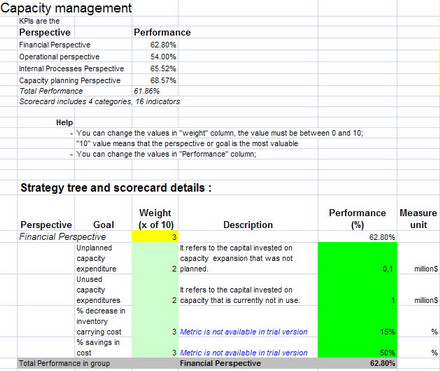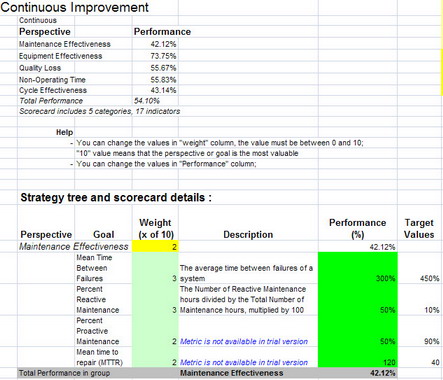The best practices of using Balanced Scorecard software in a manufacturing company
Description: The case study highlights how the Balanced Scorecard Designer can be used in a manufacturing company to improve the overall effectiveness of the organization and improve performance
Sygnus Manfucturing Systems – Developing Synergies in Manufacturing Process to attain economies of scale.
Sygnus Manufacturing Systems is a UK-based multinational enterprise dealing in automobile manufacturing since past couple of decades. The company has its operations in eight Latin American nations, each with an individual national operating firm head by a Managing Director. The Vice President for Latin America is based in Rio de Janeiro, and notifies about the combined performance of the company’s Latin American subsidiaries to the UK headquarters. In 2007, Sygnus Manufacturing Systems kicked off a strategic drive intending to attain considerable economies of scale, primarily via organizational as well as operational restructuring. The board of MDs for Latin American subsidiaries decided they required a functional framework to help them manage this crucial move, and subsequently they opted for the Balanced Scorecard Designer software for the purpose. Furthermore, developing the balanced scorecard was also aimed at helping the Latin American MDs board to build synergies in carrying out complex activities across the region.

This case study encompasses sections discussed below::
- The Client requirement;
- Procedures and best practices;
- Challenges confronted;
- Results obtained.
The Client Requirement
The design of the Latin American balanced scorecard was essentially backed by following needs:
- The requirement to proactively manage a rather complicated pan-Latin American transformation program;
- The aim to come up with an interactive framework for setting up collaboration between the MDs of the region, underpinning their roles as a concerted team, and delivering a process to steer their collaborative agenda.
Individually, the transformation program intended to bring operating costs down through a spell of operational and organizational changes across the region. The first important change includes limiting the count of manufacturing and stock piling locations to two, one in Brazil and another in Argentina. Another significant transformation incorporates amalgamating nation-level operations into three units. It further encompasses merging some pan-Latin American service functions, including sales and marketing, finance, and procurement.
In a bid to achieve the aforesaid objectives of bringing upon the necessary changes, an interactive collaboration framework among MDs was highly called for. This would ensure effective and timely delivery of projects across borders, and support the initiative to incorporate the new common services within each subsidiary.
Procedures Adopted and Best Practices
Balanced Scorecards Designer offers a trustworthy and smart procedure to design the required balanced scorecards, comprised of four whole-day workshops with the anticipated users of the accomplished system. The project undertaken with Sygnus Manufacturing Systems mainly included following processes:
- Defining a Project Group
The project included a sophisticated project group comprising experts from Balanced Scorecards Designer with delegates of the client company.
- Four Workshops
Along with the VP and MDs from Latin America, the Global Business Development Head and Chief Operational Officer of Sygnus Manufacturing also proactively participated in the balanced scorecard design procedure. Their involvement ensured alignment with the corporate objectives taken as a whole.
The standard procedure from Balanced Scorecard Designer revolves around four whole-day workshops held by around 15-days gap, and due to this, the design procedure typically takes somewhere around three months to accomplish.
- Post-development Guidance
Once the balanced scorecard is completely developed, it’s not at all a cumbersome task to maintain them. A small team within the organization is created and assigned the task of maintain the completed system; for instance, helping management team to bring upon subtle changes to the system. In this case the role was assigned two managers holding pan-Latin American positions- one from Sales and Marketing and other from Finance.
- Assessment Meetings
Balanced Scorecard finds great usage as a functional mechanism to notify and the agenda of periodic strategic assessment meetings. These important meetings revolve around making essential practical interferences to keep the strategic plans well on track, and deliver desired results, and therefore are comparatively quite frequent – traditionally after every here months. In order to make the maximum out of these periodic meetings, the company must cautiously prepare for them – gathering the data required to ‘color-in’ the balanced scorecard, and presenting comprehensive reviews of some specific issues emphasized by this information collection activity. Balanced Scorecard Designer attended few initial meetings to ensure that data collection process should be effective, and that the members of the team were using the data adequately.
Challenges Confronted
Following challenges have been faced and addressed during the entire project:
- The requirement to connect KPIs with Global Objectives
The Latin American subsidiaries were deemed to be in line with, and were assessed using a set of Global Plans and KPIs primarily put forth by the UK head office. The KPIs are designed using a traditional form of balanced scorecard which differs structurally from more advanced system. However, dynamic measures were taken to keep the new Latin American business design aligned with the UK KPIs. A concentrated effort was made towards developing a global capability management.
- Latin-American operations as a united business unit
Initially, managers were not quite accustomed to talk about Latin-American business operations as a whole, despite their constant meetings to discuss performance in their individual territories. Later on, the issue was tackled by offering a communicative framework for discussing the company’s strategic objectives in the region as a hole.

Results Obtained
The Latin-American business subsidiaries now have a full-fledged balanced scorecard and they have obtained following results:
- The board of Latin-American MDs eventually came up with a properly-defined set of pan-Latin American long and medium-term strategic objectives, which have been conveyed within the prominent Latin-American businesses;
- The organization agreed upon to put forth a set of transformational projects for the board of Latin-American MDs to work on, and the span of each project has been pinned in clear terms with an assigned owner, and roadmap for implementation approved against a preset timeline.
- The organization now has a well-trained in-house team which aimed at continuous improvement initiative and has already started helping various arms of the business to cascade the balanced scorecard for bolstering up the efficiency of the organization.
Key Insights
The case study on Synus Manufacturing systems clearly affirms the utility of the balanced scorecard as a handy business performance management tool. It further illustrates some of the latent benefits designing a balanced scorecard. Advantages specific to Sygnus Manufacturing Systems included:
- Formation and integration of a pan-Latin American management team
The entire process of developing the balanced scorecard actually instilled a shared purpose in the board of Latin American MDs. Inclusion of the Global heads of the company further ensured that these shared goals were in tune with company’s overall objectives.
- Creating an interactive forum
The process further set up a communicative channel among various components of the business to strike out new ways and devise plans in a consensual way.
- Documentation of a layout for a tactical implementation
Documenting the strategic linkage layout, comprising both the results and significant activities to be followed by the group, along with the notions about how these entities are intertwined, turns out to be an effectual aid to convey these objectives to others.
|